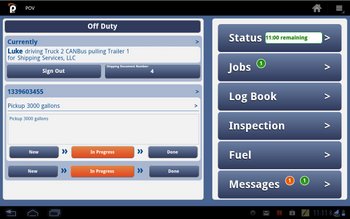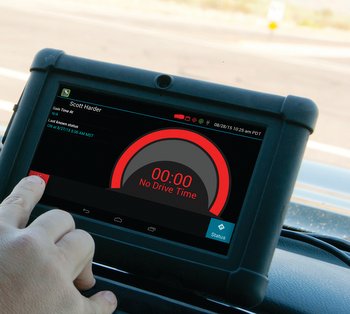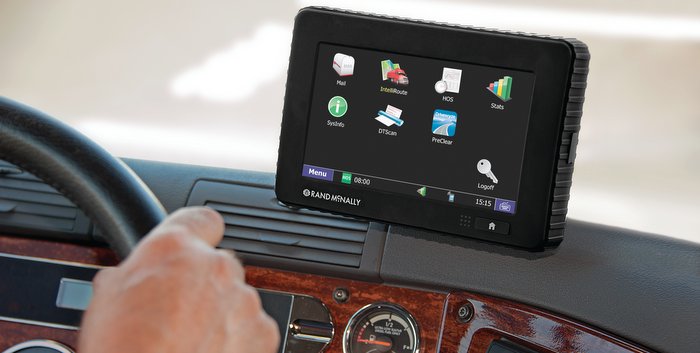While the implementation of the Federal Motor Carrier Safety Administration’s electronic logging device (ELD) rules will usher in significant changes for our industry, there are many potential benefits. Despite the startup costs and learning curves, fleets may be poised to see significant improvements.
“As fleets adopt various solutions, one of the biggest areas of concern will be education,” says Tom Cuthbertson, Omnitracs’ vice president of regulatory affairs. “Most commercial drivers will need to be using ELDs by December 2017, but those that are already using devices compatible with older automatic on-board recording device (AOBRD) standards have until December 2019 to have ELD-compliant devices in trucks. This is going to result in a number of ways to comply with hours of service (HOS), and it’s important for fleets to understand exactly which category they fall in. There are other functions within the ELD mandate, such as yard moves and unassigned vehicle moves, that may take some operational considerations for fleets.”
As of Feb. 16, manufacturers are now able to register and self-certify their ELD products, which will introduce a lot of new products into the marketplace making it even more crucial for fleets and drivers to understand which technology they have—or could purchase—and how it works.
“With the finalized mandate, fleets are also concerned about balancing compliance requirements without sacrificing efficiency and productivity,” Cuthbertson notes. “As fleets are starting to adopt ELD solutions, many are well attuned to the complementary safety-related benefits associated with regulatory compliance. What may be less obvious are the myriad of other positives that can result from implementing ELDs across a fleet. For-hire and private fleets alike report experiencing not only efficiency improvements, but also cost reduction and time savings for drivers.”
“Waiting is not a good strategy,” advises Joshua DeCock, director of product management for Pedigree Technologies. “With less than two years to have an AOBRD or ELD solution and nearly three million trucks needing installs, there will definitely be a limited supply to meet demand. Hardware, installation and training shortages are inevitable, meaning that some carriers will not be compliant in time for the December 2017

AOBRD/ELD required date. Most of our current customers don’t have much work to do to become ELD compliant, because this will be done with an over-the-air software update. Many people would be surprised to hear that for customers new to electronic logs, our biggest success is in consulting services. Our years of experience with electronic logs lets us help fleets with reluctant staff feel more comfortable with the changes and ultimately help them realize the benefits of having one platform and one login to easily manage their fleet.”
Doug Johnson, marketing director for Drivewyze, agrees. “While the implementation of an ELD mandate came as no surprise to anyone in the industry, the fact remains that a fair number of fleets still have not implemented ELDs,” he says. “Many fleets were waiting to see how things would shake out after the U.S. Seventh Circuit Court of Appeals struck down the federal government’s first ELD rule several years ago. Fleets were also waiting to see how much ELDs would cost, since cost remains one of their biggest concerns.”
The cost of implementation can vary depending on whether fleets must first purchase the equipment or if the cost of the equipment is wrapped into the monthly service fees. Since ELD manufacturers offer different options, fleets should explore their options more fully to determine which ELD best suits their operations.
“As part of that decision, fleets should look to see whether the ELD they choose offers Drivewyze weigh station bypass service because of the way it can help them more fully leverage the device’s benefits,” Johnson adds.
Clearing up confusion
“We see a lot of confusion among fleet managers in three areas: the grandfather clause, vendor certifications, and whether to act now or wait,” notes Pete Allen, executive vice president for MiX Telematics.

The grandfather clause basically says that any fleets that already have an AOBRD HOS electronic logging telematics solution like MiX’s get two extra years to be fully ELD compliant, and so their deadline is extended until Dec. 2019. That goes for any company that implements an AOBRD compliant telematics system before Dec. 1, 2017; by that date, if a fleet implements a new system, it has to be ELD compliant. “That’s leading many fleets to accelerate their plans for telematics, and get systems implemented before Dec 2017,” Allen adds. “It’s going to be a mad rush. We are already seeing increased order volume as fleets try to get ahead of that.”
Another area of confusion is ELD certification. “Vendors will have the chance to be certified, but in order to do that, we have to take an FMCSA test, which is not yet available,” Allen says. “So vendors may say they are ELD compliant—based on the current guidelines—but no vendor is actually certified yet. We’ve read the ELD rules carefully, and we already know our hardware is ELD compliant.”
Dealing with change
“There are going to be a lot of changes for both fleets, drivers and enforcement to digest,” says Elise Chianelli, director of safety and compliance for PeopleNet. “For the industry as a whole, there will be a couple of things to keep in mind when it comes to ELD adoption. The first will be the need to educate drivers on this new technology, since filling out paper logbooks is all that many drivers are used to. It is important for fleets to point out the benefits of these new devices to their drivers to help them understand that this mandate is aimed at making their jobs easier by saving them time, speeding up inspections and reducing accidents.”













